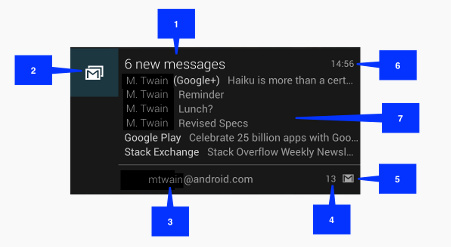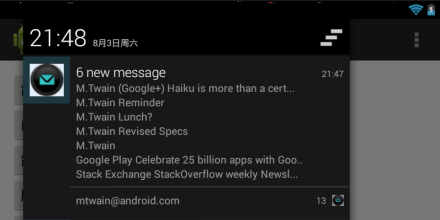原文:http://www.cnblogs.com/plokmju/p/android_Notification.html
Notification
Notification,俗称通知,是一种具有全局效果的通知,它展示在屏幕的顶端,首先会表现为一个图标的形式,当用户向下滑动的时候,展示出通知具体的内容。
注意:因为一些Android版本的兼容性问题,对于Notification而言,Android3.0是一个分水岭,在其之前构建Notification推荐使用Notification.Builder构建,而在Android3.0之后,一般推荐使用NotificationCompat.Builder构建。本文的所有代码环境均在4.3中完成,如果使用4.1一下的设备测试,请注意兼容性问题。
通知一般通过NotificationManager服务来发送一个Notification对象来完成,NotificationManager是一个重要的系统级服务,该对象位于应用程序的框架层中,应用程序可以通过它像系统发送全局的通知。这个时候需要创建一个Notification对象,用于承载通知的内容。但是一般在实际使用过程中,一般不会直接构建Notification对象,而是使用它的一个内部类NotificationCompat.Builder来实例化一个对象(Android3.0之下使用Notification.Builder),并设置通知的各种属性,最后通过NotificationCompat.Builder.build()方法得到一个Notification对象。当获得这个对象之后,可以使用NotificationManager.notify()方法发送通知。
NotificationManager类是一个通知管理器类,这个对象是由系统维护的服务,是以单例模式获得,所以一般并不直接实例化这个对象。在Activity中,可以使用Activity.getSystemService(String)方法获取NotificationManager对象,Activity.getSystemService(String)方法可以通过Android系统级服务的句柄,返回对应的对象。在这里需要返回NotificationManager,所以直接传递Context.NOTIFICATION_SERVICE即可。
虽然通知中提供了各种属性的设置,但是一个通知对象,有几个属性是必须要设置的,其他的属性均是可选的,必须设置的属性如下:
- 小图标,使用setSamllIcon()方法设置。
- 标题,使用setContentTitle()方法设置。
- 文本内容,使用setContentText()方法设置。
更新与移除通知
在使用NotificationManager.notify()发送通知的时候,需要传递一个标识符,用于唯一标识这个通知。对于有些场景,并不是无限的添加新的通知,有时候需要更新原有通知的信息,这个时候可以重写构建Notification,而使用与之前通知相同标识符来发送通知,这个时候旧的通知就被被新的通知所取代,起到更新通知的效果。
对于一个通知,当展示在状态栏之后,但是使用过后,如何取消呢?Android为我们提供两种方式移除通知,一种是Notification自己维护,使用setAutoCancel()方法设置是否维护,传递一个boolean类型的数据。另外一种方式使用NotificationManager通知管理器对象来维护,它通过notify()发送通知的时候,指定的通知标识Id来操作通知,可以使用cancel(int)来移除一个指定的通知,也可以使用cancelAll()移除所有的通知。
使用NotificationManager移除指定通知示例:
1 NotificationManager mNotificationManager = (NotificationManager) getSystemService(Context.NOTIFICATION_SERVICE); 2 mNotificationManager.cancel(0);
PendingIntent
对于一个通知而言,它显示的消息是有限的,一般仅用于提示一些概要信息。但是一般简短的消息,并不能表达需要告诉用户的全部内容,所以需要绑定一个意图,当用户点击通知的时候,调用一个意图展示出一个Activity用来显示详细的内容。而Notification中,并不使用常规的Intent去传递一个意图,而是使用PendingIntent。
先来聊聊Intent和PendingIntent的区别,PendingIntent可以看做是对Intent的包装,通过名称可以看出PendingIntent用于处理即将发生的意图,而Intent用来处理马上发生的意图。而对于通知来说,它是一个系统级的全局的通知,并不确定这个意图被执行的时间。当在应用外部执行PendingIntent时,因为它保存了触发App的Context,使得外部App可以如果当前App一样执行PendingIntent里的Intent,就算执行时触发通知的App已经不存在了,也能通过存在PendingIntent里的Context照常执行Intent,并且还可以处理Intent所带来的额外的信息。
PendingIntent提供了多个静态的getXxx()方法,用于获得适用于不同场景的PendingIntent对象。一般需要传递的几个参数都很常规,只介绍一个flag参数,用于标识PendingIntent的构造选择:
- FLAG_CANCEL_CURRENT:如果构建的PendingIntent已经存在,则取消前一个,重新构建一个。
- FLAG_NO_CREATE:如果前一个PendingIntent已经不存在了,将不再构建它。
- FLAG_ONE_SHOT:表明这里构建的PendingIntent只能使用一次。
- FLAG_UPDATE_CURRENT:如果构建的PendingIntent已经存在,则替换它,常用。
Notification视觉风格
Notification有两种视觉风格,一种是标准视图(Normal view)、一种是大视图(Big view)。标准视图在Android中各版本是通用的,但是对于大视图而言,仅支持Android4.1+的版本。
从官方文档了解到,一个标准视图显示的大小要保持在64dp高,宽度为屏幕标准。标准视图的通知主体内容有一下几个:
- 通知标题。
- 大图标。
- 通知内容。
- 通知消息。
- 小图标。
- 通知的时间,一般为系统时间,也可以使用setWhen()设置。
下面通过一个示例,模仿上面效果的通知。
btnNotification.setOnClickListener(new View.OnClickListener() { @Override public void onClick(View v) { Bitmap btm = BitmapFactory.decodeResource(getResources(), R.drawable.msg); NotificationCompat.Builder mBuilder = new NotificationCompat.Builder( MainActivity.this).setSmallIcon(R.drawable.msg) .setContentTitle("5 new message") .setContentText("twain@android.com"); mBuilder.setTicker("New message");//第一次提示消息的时候显示在通知栏上 mBuilder.setNumber(12); mBuilder.setLargeIcon(btm); mBuilder.setAutoCancel(true);//自己维护通知的消失 //构建一个Intent Intent resultIntent = new Intent(MainActivity.this, ResultActivity.class); //封装一个Intent PendingIntent resultPendingIntent = PendingIntent.getActivity( MainActivity.this, 0, resultIntent, PendingIntent.FLAG_UPDATE_CURRENT); // 设置通知主题的意图 mBuilder.setContentIntent(resultPendingIntent); //获取通知管理器对象 NotificationManager mNotificationManager = (NotificationManager) getSystemService(Context.NOTIFICATION_SERVICE); mNotificationManager.notify(0, mBuilder.build()); } });
显示效果:
而对于大视图(Big View)而言,它的细节区域只能显示256dp高度的内容,并且只对Android4.1+之后的设备才支持,它比标准视图不一样的地方,均需要使用setStyle()方法设定,它大致的效果如下:
setStyle()传递一个NotificationCompat.Style对象,它是一个抽象类,Android为我们提供了三个实现类,用于显示不同的场景。分别是:
- NotificationCompat.BigPictureStyle, 在细节部分显示一个256dp高度的位图。
- NotificationCompat.BigTextStyle,在细节部分显示一个大的文本块。
- NotificationCompat.InboxStyle,在细节部分显示一段行文本。
如果仅仅显示一个图片,使用BigPictureStyle是最方便的;如果需要显示一个富文本信息,则可以使用BigTextStyle;如果仅仅用于显示一个文本的信息,那么使用InboxStyle即可。后面会以一个示例来展示InboxStyle的使用,模仿上面图片的显示。
实现代码:
btnBigViewNotification.setOnClickListener(new View.OnClickListener() { @Override public void onClick(View v) { Bitmap btm = BitmapFactory.decodeResource(getResources(), R.drawable.msg); Intent intent = new Intent(MainActivity.this, ResultActivity.class); PendingIntent pendingIntent = PendingIntent.getActivity( MainActivity.this, 0, intent, PendingIntent.FLAG_CANCEL_CURRENT); Notification noti = new NotificationCompat.Builder( MainActivity.this) .setSmallIcon(R.drawable.msg) .setLargeIcon(btm) .setNumber(13) .setContentIntent(pendingIntent) .setStyle( new NotificationCompat.InboxStyle() .addLine( "M.Twain (Google+) Haiku is more than a cert...") .addLine("M.Twain Reminder") .addLine("M.Twain Lunch?") .addLine("M.Twain Revised Specs") .addLine("M.Twain ") .addLine( "Google Play Celebrate 25 billion apps with Goo..") .addLine( "Stack Exchange StackOverflow weekly Newsl...") .setBigContentTitle("6 new message") .setSummaryText("mtwain@android.com")) .build(); NotificationManager mNotificationManager = (NotificationManager) getSystemService(Context.NOTIFICATION_SERVICE); mNotificationManager.notify(0, noti); } });
展示效果:
进度条样式的通知
对于一个标准通知,有时候显示的消息并不一定是静态的,还可以设定一个进度条用于显示事务完成的进度。
Notification.Builder类中提供一个setProgress(int max,int progress,boolean indeterminate)方法用于设置进度条,max用于设定进度的最大数,progress用于设定当前的进度,indeterminate用于是否是一个确定进度只的进度条。通过indeterminate的设置,可以实现两种不同样式的进度条,一种是有进度的(false),一种是循环流动的(false)。下面分别用两个示例演示:
有进度的进度条,实现代码:
btnProgreNotification.setOnClickListener(new View.OnClickListener() { @Override public void onClick(View v) { manager = (NotificationManager) getSystemService(Context.NOTIFICATION_SERVICE); builder = new NotificationCompat.Builder(MainActivity.this) .setSmallIcon(R.drawable.ic_launcher) .setContentTitle("Picture Download") .setContentText("Download in progress"); builder.setAutoCancel(true); //通过一个子线程,动态增加进度条刻度 new Thread(new Runnable() { @Override public void run() { int incr; for (incr = 0; incr <= 100; incr += 5) { builder.setProgress(100, incr, false); manager.notify(0, builder.build()); try { Thread.sleep(300); } catch (InterruptedException e) { Log.i(TAG, "sleep failure"); } } builder.setContentText("Download complete") .setProgress(0, 0, false); manager.notify(0, builder.build()); } }).start(); } });
显示效果:
对于循环流动的进度条,下面是实现代码:
btnProNotification.setOnClickListener(new View.OnClickListener() { @Override public void onClick(View v) { manager = (NotificationManager) getSystemService(Context.NOTIFICATION_SERVICE); builder = new NotificationCompat.Builder(MainActivity.this) .setSmallIcon(R.drawable.ic_launcher) .setContentTitle("Picture Download") .setContentText("Download in progress"); builder.setProgress(0, 0, true);//设置为true,表示流动 manager.notify(0, builder.build()); //5秒之后还停止流动 new Thread(new Runnable() { @Override public void run() { try { Thread.sleep(5000); } catch (InterruptedException e) { e.printStackTrace(); } builder.setProgress(100, 100, false);//设置为true,表示刻度 manager.notify(0, builder.build()); } }).start(); } });
效果展示:
自定义通知
和Toast一样,通知也可以使用自定义的XML来自定义样式,但是对于通知而言,因为它的全局性,并不能简单的通过inflate膨胀出一个View,因为可能触发通知的时候,响应的App已经关闭,无法获取当指定的XML布局文件。所以需要使用单独的一个RemoteViews类来操作。
RemoteViews,描述了一个视图层次的结构,可以显示在另一个进程。层次结构也是从布局文件中“膨胀”出一个视图,这个类,提供了一些基本的操作求改其膨胀的内容。
RemoteViews提供了多个构造函数,一般使用RemoteViews(String packageName,int layoutId)。第一个参数为包的名称,第二个为layout资源的Id。当获取到RemoteViews对象之后,可以使用它的一系列setXxx()方法通过控件的Id设置控件的属性。最后使用NotificationCompat.Builder.setContent(RemoteViews)方法设置它到一个Notification中。
下面通过一个示例展示它:
自定义的布局XML代码:
<?xml version="1.0" encoding="utf-8"?> <RelativeLayout xmlns:android="http://schemas.android.com/apk/res/android" android:layout_width="match_parent" android:layout_height="match_parent" android:padding="10dp" > <ImageView android:id="@+id/imageNo" android:layout_width="wrap_content" android:layout_height="match_parent" android:layout_alignParentLeft="true" android:layout_marginRight="10dp" /> <TextView android:id="@+id/titleNo" android:layout_width="wrap_content" android:layout_height="wrap_content" android:layout_toRightOf="@id/imageNo" /> <TextView android:id="@+id/textNo" android:layout_width="wrap_content" android:layout_height="wrap_content" android:layout_below="@id/titleNo" android:layout_toRightOf="@id/imageNo" /> </RelativeLayout>
实现代码:
btnCustomNotification.setOnClickListener(new View.OnClickListener() { @Override public void onClick(View v) { RemoteViews contentViews = new RemoteViews(getPackageName(), R.layout.custom_notification); //通过控件的Id设置属性 contentViews .setImageViewResource(R.id.imageNo, R.drawable.btm1); contentViews.setTextViewText(R.id.titleNo, "自定义通知标题"); contentViews.setTextViewText(R.id.textNo, "自定义通知内容"); Intent intent = new Intent(MainActivity.this, ResultActivity.class); PendingIntent pendingIntent = PendingIntent.getActivity( MainActivity.this, 0, intent, PendingIntent.FLAG_CANCEL_CURRENT); NotificationCompat.Builder mBuilder = new NotificationCompat.Builder( MainActivity.this).setSmallIcon(R.drawable.ic_launcher) .setContentTitle("My notification") .setTicker("new message"); mBuilder.setAutoCancel(true); mBuilder.setContentIntent(pendingIntent); mBuilder.setContent(contentViews); mBuilder.setAutoCancel(true); NotificationManager mNotificationManager = (NotificationManager) getSystemService(Context.NOTIFICATION_SERVICE); mNotificationManager.notify(10, mBuilder.build()); } });
效果展示:
设定提示响应
对于有些通知,需要调用一些设备的资源,使用户能更快的发现有新通知,一般可设定的响应有:铃声、闪光灯、震动。对于这三个属性,NotificationCompat.Builder提供了三个方法设定:
- setSound(Uri sound):设定一个铃声,用于在通知的时候响应。传递一个Uri的参数,格式为“file:///mnt/sdcard/Xxx.mp3”。
- setLights(int argb, int onMs, int offMs):设定前置LED灯的闪烁速率,持续毫秒数,停顿毫秒数。
- setVibrate(long[] pattern):设定震动的模式,以一个long数组保存毫秒级间隔的震动。
大多数时候,我们并不需要设定一个特定的响应效果,只需要遵照用户设备上系统通知的效果即可,那么可以使用setDefaults(int)方法设定默认响应参数,在Notification中,对它的参数使用常量定义了,我们只需使用即可:
- DEFAULT_ALL:铃声、闪光、震动均系统默认。
- DEFAULT_SOUND:系统默认铃声。
- DEFAULT_VIBRATE:系统默认震动。
- DEFAULT_LIGHTS:系统默认闪光。
而在Android中,如果需要访问硬件设备的话,是需要对其进行授权的,所以需要在清单文件AndroidManifest.xml中增加两个授权,分别授予访问振动器与闪光灯的权限:
<!-- 闪光灯权限 --> <uses-permission android:name="android.permission.FLASHLIGHT"/> <!-- 振动器权限 --> <uses-permission android:name="android.permission.VIBRATE"/>
因为只是一个属性的设定,并且大部分时候,使用系统设定即可,这里就不提供代码示例了。






